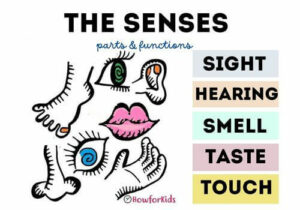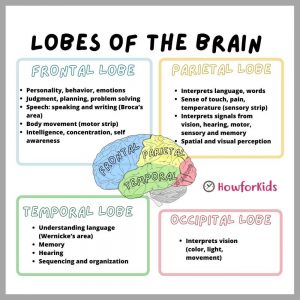What is the Nervous System?
Table of Contents
The nervous system is the set of control and information organs and structures of the human body, made up of highly differentiated cells, known as neurons, which are capable of transmitting electrical impulses along a large network of nerve endings. Let’s explain the Human Nervous System Parts and functions for students.
What is the function of the Nervous System in Humans?

The Nervous System controls and coordinates the human body. It is a complex network of nerves and cells that carry messages between the brain and spinal cord to all parts of the body.
The nervous system is responsible for relating to the environment around us. We continually receive stimuli from the environment and from within our body. Stimuli are signals that indicate that something has changed in the environment around us. This causes reactions in the body. When our body reacts to these stimuli, we say that it “gives a response” that is transmitted through the nervous system to the brain.
The Nervous System’s Functions
The Nervous System is in charge of controlling all the activities of the organism. Thanks to the nervous system we are able to know what is happening around us.
The stimuli that come from the outside are received through the sense organs: the eyes, nose, tongue, ears and skin. The signals travel from the sense organs to the brain, which gives the appropriate response to act.
Read also: The 5 sense Organs for kids
How does the Nervous System Work?
Some functions depend on our will, such as walking. On the other hand, other functions don’t depend on us, such as the digestion of the food we eat, or breathing. Another example is our heart that “beats” involuntarily.
The nervous system is also responsible for saving our memories as it controls our feelings of joy, sadness or pain. It is responsible for perceiving, understanding and responding to information from different parts of the body through nerves and neurons.
Parts of the Neuron in the Human Body
The nervous system is made up of nerve cells called neurons. They transmit signals in our body through electro-chemical nerve impulses. They are highly specialized conducting cells and the basic unit of the nervous system.
Fun fact: Gut-Brain Connection
Why is the gut called the “second brain”?
There are neurons in the gut. Neurons exist in the brain, in the spinal cord but they are also in the digestive system. That is why it is known as “second brain”. Because the enteric nervous system depends on the same type of neurons and neurotransmitters found in the central nervous system. The “second brain” in our gut, in communication with the brain, plays a key role in the onset of certain diseases in our bodies and in our mental health in general.
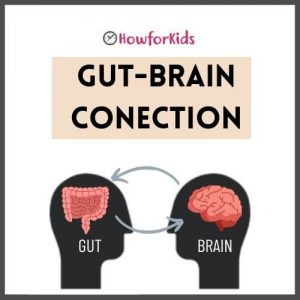
This network of neural connections located in the intestine is as extensive and complex as that of our spinal cord. Now let’s ask ourselves:
Why does the gut need its own “brain”? Just to handle the digestion process?
This “second brain” has the function of attending to the trillions of microorganisms that reside inside it. The human intestine houses in the microbiota a wide variety of microbial organisms that maintain a symbiotic and important relationship to ensure well-being.
Parts of a Neuron and their Functions
Neurons are covered by a substance called myelin or Schwann cells. They are white segments that cover around axons and dendrites of many peripheral neurons. Myelin protects nerve fibers and helps messages travel faster through neurons.
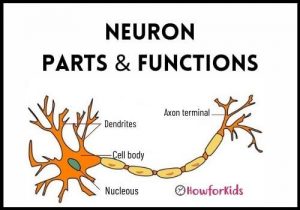
Cell Body or Soma
The cell body is like any other cell with a nucleus or control center.
Dendrites
The cell body has several thick, highly branched cable-like extensions called dendrites. The exception is a sensory neuron that has a single long dendrite instead of many dendrites. Motor neurons have multiple thick dendrites. The function of the dendrite is to carry a nerve impulse to the cell body.
Axon
An axon is a long, thin extension that transmits impulses from the cell body to another neuron or tissue. There is usually only one axon per neuron.
Types of Neurons and their Functions
Neurons are classified based on function and morphology.
1. By their Function
• Sensory (afferent) neurons, which conduct nerve impulses from the periphery to the central nervous system.
• Motor (efferent) neurons, which conduct impulses from the central nervous system to the periphery.
• Interneurons, which are sometimes interposed between motor and sensory neurons. Its function is to integrate and modulate the communication between them.
2. By Morphology
• Multipolar neurons have one axon and several dendrites. These are common in the brain and spinal cord.
• Bipolar neurons have two processes: an axon (output) and a dendrite (input). These are seen in the eye (retina), inner ear (cochlea and vestibule), and in the olfactory mucosa.
• Unipolar neurons have a single two-way process that extends from the body of the neuron. It divides with one part acting as an axon and the other part functioning as a dendrite (input and output). They are usually sensory neurons, that is, afferents. These are seen in the spinal cord.
• Most sensory neurons are pseudounipolar, which means they only have one axon which is split into two branches.
What is a Synapse? How Neurons Talk to Each Other
The word synapse comes from the Greek meaning “union” or “link“. For information to travel, neurons must connect to each other creating circuits. Neurons connect through synapses. It is the junction between two nerve cells where a nerve impulse is transmitted from one nerve to another. Synapses are normally established between an axon to another cell (which may not be another neuron).
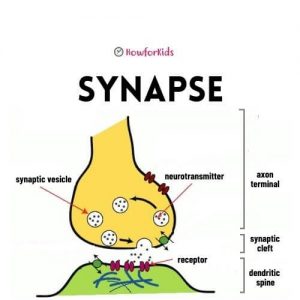
How Do Synapses Work? Types of Synapses
- Axosomatic synapses: axon to soma or cell body.
- Axodendritic synapses: axon to dendrite.
- Axoaxonic synapses: axon to axon.
- Neuromuscular junction: from axon to muscle cell.
It is estimated that the adult brain has approximately 100,000 million neurons. Each neuron can connect with 50,000 other neurons. The transmission of information along the neurons is carried out by electrical impulses, and in the synapses by chemical neurotransmitters (acetylcholine, gamma-aminobutyric acid or GABA, dopamine, serotonin, norepinephrine, glutamate, acetylcholine).
What is a Nerve?
A nerve is a fiber that sends impulses through the body. The protoplasmic extensions of the nerve cells form the neural pathways called nerves. Sensory and motor impulses are conducted through the nerves just like the wires of the flowing electrical current.
Types of Nerves
1. Depending on where they take the information
• Afferent nerves: carry the stimuli received by the sense organs or other organs to the brain.
• Efferent nerves: They conduct the impulse from the brain to the muscles or glands.
2. Depending on where they originate
• Cranial: are born in the area of the brain or bulb.
• Spinal: they originate in the spinal cord.
3. According to its function in the body
• Sensory nerves: are those that enter the Central Nervous System (CNS) and come from the sense organs.
• Motor nerves: They are the ones that leave the CNS carrying information to the rest of the body (to the glands and muscles).
4. When they provoke some kind of movement
• If the movement is voluntary, they are called somatic nerves.
• If the movement is involuntary, they are called autonomic nerves.
Nervous System Functions
• Sensory: It perceives internal and external stimuli or changes from the sense organs. For example, it captures light, the pressure felt on the skin, the concentration of chemical substances dissolved in food or in aromas.
• Motor: It causes responses by activating muscles or glands. The nervous system can stimulate or inhibit muscles and glands to act or stop acting.
What is the most important function of the Nervous System?
The function of the nervous system without which life would not be possible is the adaptation of the organism to the environment. Along with the endocrine system, it is the director and coordinator of all the conscious and unconscious activities of the organism.
Our body can capture information, both from the external environment and from within the body. This information is processed by the nervous system and is used to make the orders that govern its operation.
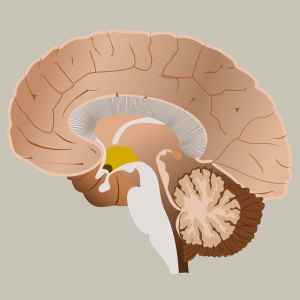
What are the Parts of the Nervous System?
How is the Nervous System divided? For its study, from the anatomical point of view the nervous system is divided into the central nervous system and the peripheral nervous system.
How is the Nervous System formed?
The Central Nervous System is made up of the brain and spinal cord, and the Peripheral Nervous System is made up of the spinal nerves and cranial nerves.
Central Nervous System: Summary
Organs of the Central Nervous System
The CNS serves as a main “processing and coordination center” where all the activities of the body are controlled.
Parts of the Central Nervous System: Structure of the CNS
Parts of the CNS and their functions. The Central Nervous System is made up of the brain and the spinal cord.
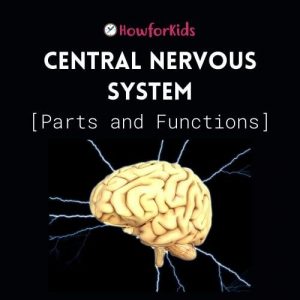
Encephalon
The brain is divided into three parts: the brain stem, the cerebellum, and the cerebrum proper.
1. Brain Stem
It is located on the spinal cord and is composed of: Mesencephalon, pons and the medulla oblongata. Function: Controls functions of your body such as digestion, breathing and heartbeat. From there the twelve pairs of cranial nerves are born.
– Medulla oblongata
The medulla oblongata is a swelling located at the top of the spinal cord. It joins the brain with the spinal cord. Main function: controls involuntary movements such as heartbeat or eyelid movement.
– Annular Bulge (or Varolio’s Bridge). Its function is to connect the medulla oblongata with the cerebral hemispheres.
– Mesencephalon (or Midbrain) Conducts motor impulses from the cerebral cortex to the pons and conducts sensory impulses from the spinal cord to the thalamus.
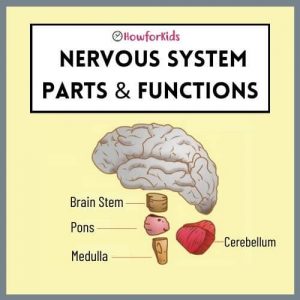
2. Cerebellum: Functions
The cerebellum is located at the back of the head. The main role of the Cerebellum:
- It controls fine and coordinated movements (running, walking, writing, threading a needle, drawing lines) It also coordinates speech (the movements that allow you to speak).
- It maintains muscle tone and body posture.
- It processes the information coming from the inner ear related to the balance of the body.
It was once believed that the only function of the cerebellum was to coordinate movements. However, we now understand that the cerebellum plays a much larger role in a variety of functions and communicates signals to other areas of the brain. Some of the associated functions of the cerebellum:
- Coordination of voluntary movement.
- Balance.
- Position.
- Motor learning.
- Sequence learning.
- Reflex memory.
- Mind function.
- Emotional processing.
3. Brain or Cerebrum
The brain is the one who commands our entire organism. It controls and regulates most of the body’s functions. It receives signals called stimuli and gives the appropriate response. If we feel that something is very hot or causes us pain, it gives us the indication to withdraw quickly and not hurt ourselves.
Brain Location
The brain is located inside our head called the skull and constitutes the main mass of the brain.
Brain: Fun Facts
The term “brain” is incorrectly used to refer to the entire contents of the skull, which is actually called the brain. Bony structures, such as the skull and spinal column, have the function of protecting the brain and spinal cord from injury.
Also read: The Human Brain: Functions and Anatomy for students
Spinal Cord
The spinal cord is a thick cord made up of many neurons, which is located inside the spinal column and establishes the connection between the brain and the rest of the body. It is the pathway that conducts impulses to and from the brain and is also responsible for reflex actions, such as reacting when touching something very hot.
The 31 pairs of spinal nerves arise from the medulla. There are eight cervical nerves, twelve dorsal, five lumbar, five sacral and one coccygeal.
These nerves, which connect the spinal cord with the rest of the body, are grouped into networks called plexuses: cervical, brachial, lumbar, sacral and sacral-coccygeal.
It fulfills two basic functions: the afferent, in which it carries sensory sensations from the trunk, neck, and the four limbs to the brain, and the efferent, in which it sends impulses from the brain to the trunk, neck, and limbs.
It also controls automatic or reflex reactions.
Peripheral Nervous System (PNS)
The peripheral nervous system (PNS) is made up of nerves and neurons that extend outside the central nervous system (CNS), to the limbs and organs.
The difference between this and the CNS is that the peripheral nervous system is not protected by bones or by the blood-brain barrier, which allows exposure to toxins and mechanical damage. The peripheral nervous system is the one who coordinates, regulates and integrates our internal organs through unconscious responses.
Read also: The Human Body easy for kids
The Peripheral NS is subdivided into:
• Somatic nervous system: Activates all organic functions (it is active).
• Autonomic or vegetative nervous system: Protects and moderates energy expenditure. It is made up of billions of long neurons, many grouped into nerves. It serves to transmit nerve impulses between the CNS and other areas of the body.
Peripheral nerves: They have three layers: endoneurium, perineurium and epineurium.
